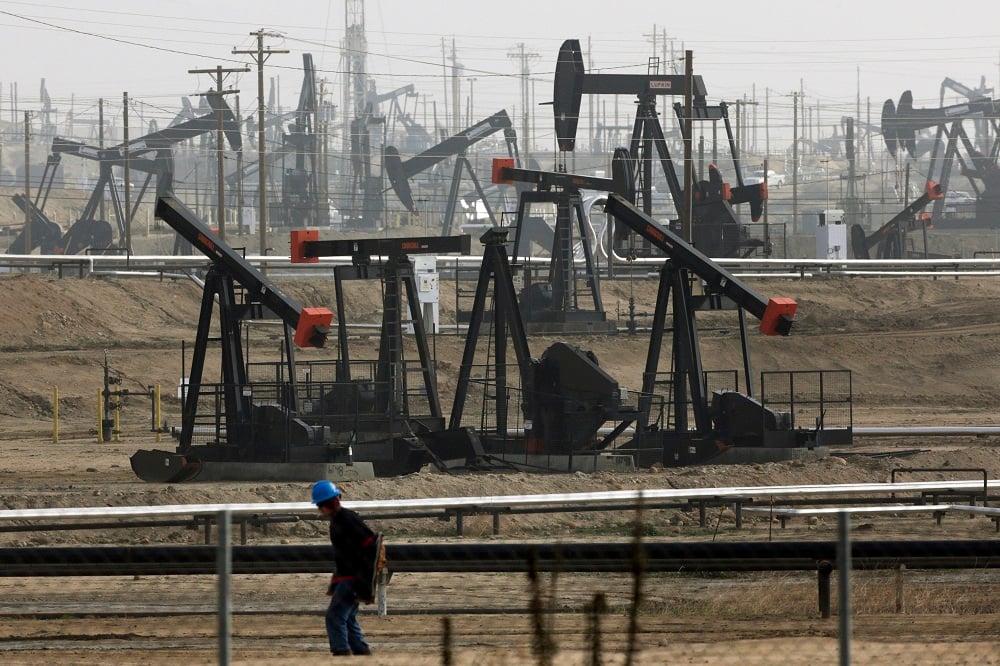(CN) — In a win for environmentalists and social justice organizations, California Governor Gavin Newsom announced new rules Thursday requiring 3,200 feet of buffer space between homes, schools and hospitals and new oil wells.
But the event was also a reminder that Newsom is as aggressive as any major political figure in America at taking on the fossil fuel industry, as he and other lawmakers work to effect a transition to an energy portfolio almost entirely composed of renewable energy.
“I don’t see oil in our future,” Newsom said.
Newsom concentrated Thursday on stoking enthusiasm for the regulation released by the Department of Conservation’s Geologic Energy Management Division that requires new wells and oil extraction facilities to be placed a little more than a half-mile away from houses and other sensitive locations.
“Two million Californians live within a half-mile radius of wells and other facilities,” Newsom said, saying that the regulations will effect 30% of oil operations.
The press conference was held in Wilmington, a community in Los Angeles County that sits astride the third-largest oilfield in the continental U.S.
Several public health officials were on hand to discuss the importance of restricting oil extraction operations in communities plagued by air pollution. A landmark study conducted by USC in 1992 which looked at the health of children in communities like Wilmington that are near oil and gas operations found early exposure to pollutants can have life-long consequences.
“The last 20 months have taught us all the importance of healthy lung function,” said Dr. Jaime Rutland, the national spokesman for the American Lung Association, referring to the Covid pandemic.
Rutland said communities near oil wells have higher rates of respiratory disease, asthma and birth weight problems.
“Poor health outcomes are facing too many of these residents,” he said.
Assemblyman Al Muratsuchi, D-Torrance, said he’d been trying to pass legislation that created setbacks in polluted communities for years but routinely butted up against a powerful coalition between legislators and trade unions.
“Neighborhood oil drilling must stop,” he said.
State Senator Lena Gonzalez, D-Long Beach, said she was tired of her district being called “asthma alley.” Many of the environmental justice organizations that have been fighting neighborhood drilling celebrated Thursday’s announcement.
“Residents of environmental justice communities in Kern County, like those living in Lamont, Arvin, Lost Hills who have for decades been suffocated with dangerous gases from the oil facilities surrounding their homes, are finally receiving good news,” said Nayamin Martinez, executive director of Central California Environmental Justice Network, in a press release.
But there are critics of the rules who say California’s demonization of the oil and gas industry will actually hurt the people they purport to help by eliminating tax revenues the operations bring to the communities.
Critics also say hurting the oil and gas industry during a time of explosive energy costs is a poor way to help the communities of color the government claims to be helping.
“Just a few weeks ago, President Biden asked the OPEC nations, such as Saudi Arabia, Iran, Iraq and Venezuela, specifically to produce more oil in order to bring energy costs down and ensure reliability,” said Western Petroleum Association president and CEO Catherine Reheis-Boyd in a prepared statement. “Today, Governor Newsom took an opposing path and proposed a setback regulation that could lead to increased costs and reduce the reliability of our energy supply. His decision was not based on what is best for Californians or science.”
The industry also claims the setback amount is arbitrary, is not based on science and was devised for political reasons.
But the Newsom administration say they relied on a 15-member public health expert panel selected by the University of California, Berkeley, and Physicians, Scientists, and Engineers (PSE) for Healthy Energy.
“This process unfolded over two years and involved more than 40,000 public comments,” Newsom said on Thursday.
But critics say that process was stacked and fundamentally biased.
“This was not a scientific process, as facts do not support the recommendation, nor were dissenting voices or industry experts even allowed to provide input to the panel,” Reheis-Boyd said. “It’s time we call these series of actions, bans, rules and mandates what they are: an activist assault on California’s way of life, economy and people.”
California’s oil and gas production has been declining since its peak of 400,000 barrels in 1985. In 2020, California produced about 143,000 barrels of oil, the fewest in 40 years. California continues to provide about 2.4% of the oil production in the country.
Subscribe to Closing Arguments
Sign up for new weekly newsletter Closing Arguments to get the latest about ongoing trials, major litigation and hot cases and rulings in courthouses around the U.S. and the world.








